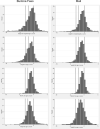Nutritional status in young children prior to the malaria transmission season in Burkina Faso and Mali, and its impact on the incidence of clinical malaria
- PMID: 34158054
- PMCID: PMC8220741
- DOI: 10.1186/s12936-021-03802-2
Nutritional status in young children prior to the malaria transmission season in Burkina Faso and Mali, and its impact on the incidence of clinical malaria
Abstract
Background: Malaria and malnutrition remain major problems in Sahel countries, especially in young children. The direct effect of malnutrition on malaria remains poorly understood, and may have important implications for malaria control. In this study, nutritional status and the association between malnutrition and subsequent incidence of symptomatic malaria were examined in children in Burkina Faso and Mali who received either azithromycin or placebo, alongside seasonal malaria chemoprevention.
Methods: Mid-upper arm circumference (MUAC) was measured in all 20,185 children who attended a screening visit prior to the malaria transmission season in 2015. Prior to the 2016 malaria season, weight, height and MUAC were measured among 4149 randomly selected children. Height-for-age, weight-for-age, weight-for-height, and MUAC-for-age were calculated as indicators of nutritional status. Malaria incidence was measured during the following rainy seasons. Multivariable random effects Poisson models were created for each nutritional indicator to study the effect of malnutrition on clinical malaria incidence for each country.
Results: In both 2015 and 2016, nutritional status prior to the malaria season was poor. The most prevalent form of malnutrition in Burkina Faso was being underweight (30.5%; 95% CI 28.6-32.6), whereas in Mali stunting was most prevalent (27.5%; 95% CI 25.6-29.5). In 2016, clinical malaria incidence was 675 per 1000 person-years (95% CI 613-744) in Burkina Faso, and 1245 per 1000 person-years (95% CI 1152-1347) in Mali. There was some evidence that severe stunting was associated with lower incidence of malaria in Mali (RR 0.81; 95% CI 0.64-1.02; p = 0.08), but this association was not seen in Burkina Faso. Being moderately underweight tended to be associated with higher incidence of clinical malaria in Burkina Faso (RR 1.27; 95% CI 0.98-1.64; p = 0.07), while this was the case in Mali for moderate wasting (RR 1.27; 95% CI 0.98-1.64; p = 0.07). However, these associations were not observed in severely affected children, nor consistent between countries. MUAC-for-age was not associated with malaria risk.
Conclusions: Both malnutrition and malaria were common in the study areas, high despite high coverage of seasonal malaria chemoprevention and long-lasting insecticidal nets. However, no strong or consistent evidence was found for an association between any of the nutritional indicators and the subsequent incidence of clinical malaria.
Keywords: Acute malnutrition; Burkina Faso; Chronic malnutrition; Malaria; Mali; Seasonal malaria chemoprevention.
Conflict of interest statement
The authors declare that they have no competing interests.
Figures


References
-
- WHO. Malaria factsheet. Geneva: World Health Organization; 2020. https://www.who.int/news-room/fact-sheets/detail/malaria.
-
- WHO . World Malaria Report 2019. Geneva: World Health Organization; 2019.
-
- WHO . High Burden to High Impact: A targeted malaria response. Geneva: World Health Organization; 2019.
-
- President’s Malaria Initiative. Mali Country Profile. 2018. https://www.pmi.gov/docs/default-source/default-document-library/country... is the primary cause,the main cause of infection.
-
- Ministère de la Santé Burkina Faso. Annuaire statistique. 2018. http://www.cns.bf/IMG/pdf/annuaire_ms_2018.pdf.
MeSH terms
Substances
Grants and funding
LinkOut - more resources
Full Text Sources
Medical

